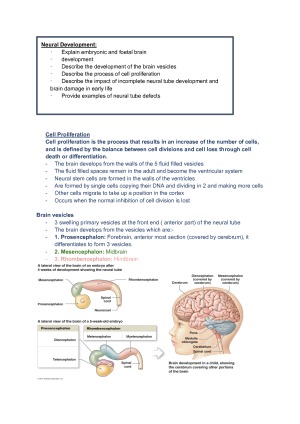SPE2104 exam notes
Subject notes for ECU SPE2104
Description
covers all exam topics - neurology - hearing - fluency Neural Development: • Explain embryonic and foetal brain • development • Describe the development of the brain vesicles • Describe the process of cell proliferation • Describe the impact of incomplete neural tube development and brain damage in early life • Provide examples of neural tube defects Gross Neuroanatomy: • To review the main structures of the • Human Brain • To identify structures of the hindbrain, midbrain and the forebrain • To describe functions involved with structures of the brain • To identify and describe functions of the lobes The neuron: • To identify the components of a typical • neuron • To describe the process of neural transmission • To define the role of neurotransmitters for neural transmission • To apply knowledge of neural transmission to neurologically based diseases such as Multiple Sclerosis Neural Networks: • To contrast sensory and motor functions • To identify components of sensory neural pathways • To identify components of motor neural pathways • To describe the difference between corticobulbar and corticospinal tracts • To identify clinical signs that can distinguish between damage to the corticobulbar tract versus the corticospinal tract Cranial Nerves: • For each of the 12 cranial nerves: • The name and number of the nerve. • The general function of the cranial nerve. Blood flow: • To explain the cerebral blood flow and networks • To name the components of the Circle of Willis • To describe the protective mechanisms of the brain • To explain the functions of cerebrospinal fluid • To explain how knowledge of structure and function of the brain is relevant to speech pathology ranges of practice. Hearing : Describe prenatal hearing development. • Identify risk factors for developing a hearing loss. • Outline the newborn hearing screening programme. • How we hear: Beyond the basics • Consequences of hearing loss and tinnitus • How to read an audiogram • Degrees of hearing loss • Types, causes, and prevalence of hearing loss • Types of tests • To define what a cochlear implant is • To identify main components of a cochlear implant • To describe who may be suitable for a cochlear implant • Describe the role of the speech pathologist and the audiologist within a clinical team • Identify structures required for hearing • Describe the processes for the function of hearing • Describe the difference between conductive hearing loss and sensorineural hearing loss • Describe different hearing assessments and what they aim to measure functionally • Identify examples of hearing disorders and their causes • Interpret an audiogram Fluency : • To apply a model/theoretical framework for assessment of communication impairment or disorder • To examine Levelt’s theory in detail • To evaluate van Der Merwe’s Neurolinguistic model of • speech • To compare and contrast the two models above • To apply principles of sensorimotor theory to range of practice: fluency, voice and swallowing • Explain the epidemiology of stuttering • Describe the major characteristics/behaviours of • stuttering in children and adults • Describe some factors found to contribute to persistent stuttering • Describe the nature of stuttering (variability and predictability) • Explain how the Variability model accounts for conditions when stuttering is reduced • Define the three types of causal factors: predisposition, precipitating, perpetuating. • Explain broadly the major theoretical stances of stuttering and what the current stance of stuttering is • To identify important information to be gathered as part of the case- history for clients who stutter • Describe how stuttering disfluencies are different to normal disfluencies, particularly for diagnosis of stuttering in young children • Explain common procedures and measures of stuttering (E.g., percent syllables stuttered, parent rating scales) as well as covert stuttering in children, adolescents and adults who stutter, and impact of quality of life • To understand the concept of stuttering severity • Describe sampling issues associated with fluency measurement • Consider methods of measuring the biopsychosocial and psychological effects of stuttering includes extra - resources such as - graphs - diagrams - case studies
ECU
Semester 1, 2017
49 pages
8,500 words
$29.00
4
